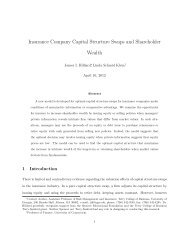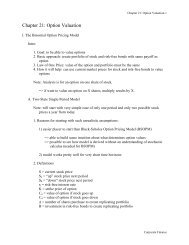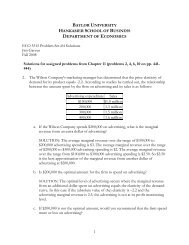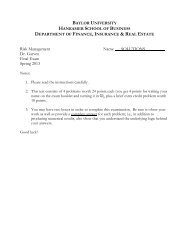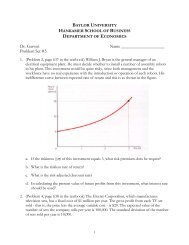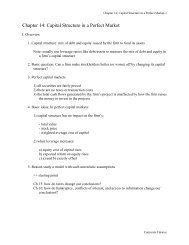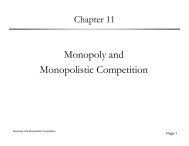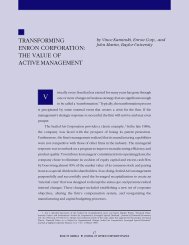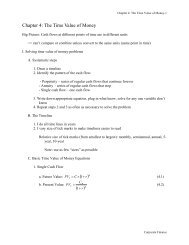Monopoly and Monopolistic Competition
Monopoly and Monopolistic Competition
Monopoly and Monopolistic Competition
You also want an ePaper? Increase the reach of your titles
YUMPU automatically turns print PDFs into web optimized ePapers that Google loves.
<strong>Monopoly</strong> <strong>and</strong> <strong>Monopolistic</strong> <strong>Competition</strong><br />
Chapter 11<br />
<strong>Monopoly</strong> <strong>and</strong><br />
<strong>Monopolistic</strong> <strong>Competition</strong><br />
Page 1
<strong>Monopoly</strong> <strong>and</strong> <strong>Monopolistic</strong> <strong>Competition</strong><br />
Page 2
<strong>Monopoly</strong> <strong>and</strong> <strong>Monopolistic</strong> <strong>Competition</strong><br />
Page 3
<strong>Monopoly</strong> <strong>and</strong> <strong>Monopolistic</strong> <strong>Competition</strong><br />
Page 4
<strong>Monopoly</strong> <strong>and</strong> <strong>Monopolistic</strong> <strong>Competition</strong><br />
Page 5
Numerical Example<br />
• You work for Nuxo Lighting Company. Nuxo<br />
produces d specialized i li dli lighting h i fi fixtures, generally ll<br />
acknowledged as the best in their class, <strong>and</strong> there are<br />
no close substitutes. substitutes A market-research market research firm has<br />
estimated the market dem<strong>and</strong> to be Q = 2,000 - 5P<br />
• You estimate Nuxo's Nuxo s total cost for producing, producing<br />
storing, <strong>and</strong> marketing it's lighting line to be TC =<br />
100 + 4Q + 0.4Q2 Q Q<br />
• You are asked to estimate how many lights should<br />
be manufactured, <strong>and</strong> how should they be priced to<br />
maximize profits?<br />
<strong>Monopoly</strong> <strong>and</strong> <strong>Monopolistic</strong> <strong>Competition</strong><br />
Page 6
Numerical Example<br />
• Invert dem<strong>and</strong> function: Q = 2000 - 5P so, 5P =<br />
2000 - QQ; hhence, P = 400 -.2Q 2Q<br />
• Find TR: PQ = 400Q -.2Q 2<br />
• derive MR; MR = 400 - .4Q<br />
• derive MC; MC = 4 + .8Q<br />
• Set MC = MR ⇒ 400 - .4Q = 4 + .8Q ⇒ 1.2Q =<br />
396; ⇒∴ Q = 330; P = 400 - .2(330) = $334, <strong>and</strong><br />
400Q 2Q2 100 4Q 04Q2 396Q 6Q2 100 = $65,240.<br />
π = 400Q -.2Q 2 - 100 - 4Q - 0.4Q 2 = 396Q -.6Q 2 -<br />
<strong>Monopoly</strong> <strong>and</strong> <strong>Monopolistic</strong> <strong>Competition</strong><br />
Page 7
<strong>Monopoly</strong> <strong>and</strong> <strong>Monopolistic</strong> <strong>Competition</strong><br />
Page 8
Chapter Summary<br />
• Under monopoly, a firm maximizes profit if it<br />
sets its output rate at the point where marginal<br />
revenue equals marginal cost.<br />
• AAn iindustry d t that th t is i monopolized li d generally ll sets t<br />
a higher price <strong>and</strong> a lower output than if it<br />
were perfectly f tl competitive. titi<br />
• The perfectly competitive firm operates at a point<br />
at twhich hi hp price i equals l marginal i lcost, t whereas h th the<br />
monopolist operates at a point at which marginal<br />
revenue equals marginal cost (<strong>and</strong> price exceeds<br />
marginal cost).<br />
<strong>Monopoly</strong> <strong>and</strong> <strong>Monopolistic</strong> <strong>Competition</strong><br />
Page 9
Chapter Summary<br />
• Cost-plus pricing only results in profit maximization if<br />
marginal g cost marked up pby ythe product's p price p<br />
elasticity of dem<strong>and</strong><br />
• Profit maximization for multi-product p firms<br />
• Fixed proportions: profit maximizing output occurs where<br />
the total marginal revenue curve intersects the marginal<br />
cost curve ffor the h bbundle dl of fproducts d ( (assuming i that h the h<br />
marginal revenue of each product is nonnegative)<br />
• Variable proportions: p p profit p maximizing goutput p occurs at<br />
the tangency point where profit is the highest; this also<br />
indicates the the optimal output combination.<br />
<strong>Monopoly</strong> <strong>and</strong> <strong>Monopolistic</strong> <strong>Competition</strong><br />
Page 10
Chapter Summary<br />
• <strong>Monopolistic</strong>ally competitive firms<br />
• MMaximize i i profit fi bby setting i MR = MC MC.<br />
• Should set advertising so that the marginal<br />
revenue from an extra dollar of advertising<br />
equals the negative of its price elasticity of<br />
dem<strong>and</strong>.<br />
<strong>Monopoly</strong> <strong>and</strong> <strong>Monopolistic</strong> <strong>Competition</strong><br />
Page 11
Chapter 11 Quiz<br />
1. If Harry Doubleday's price elasticity of dem<strong>and</strong> is -2 <strong>and</strong> its profit maximizing price is $6,<br />
then<br />
A. average cost is $3.00.<br />
B. average cost is $.33.<br />
C. marginal cost is $3.00.<br />
D. marginal cost is $.33.<br />
E. average cost is $5.67.<br />
2. My Big Banana (MBB) has a monopoly in Middletown, United States, on large banana splits.<br />
The dem<strong>and</strong> for this delicacy is given by Q = 80 - P. MBB's costs are given by TC = 40 +<br />
2Q + 2Q2. Its maximum monopoly profits are<br />
A. $267.<br />
B. $467.<br />
C. $627.<br />
D. $672.<br />
E. $674.<br />
Note: The profit maximizing price is<br />
P = MC /[1 + (1/ η )] (see equation (11.3).<br />
Therefore, 6 = MC /[1 −.5] ⇒MC = $3.<br />
2 2<br />
Note: π = (80 − Q ) Q−40 −2Q− 2 Q = 78 Q−40 − 3 Q .<br />
Therefore, dπ / dQ = 78 − 6Q = 0 ⇒ Q = 13 <strong>and</strong> P = 80 − Q = 67 ⇒<br />
2<br />
π = 67(13) −40 −2(13) − 2(13 ) =<br />
$467.<br />
<strong>Monopoly</strong> <strong>and</strong> <strong>Monopolistic</strong> <strong>Competition</strong> Page 12
Chapter 11 Quiz<br />
3. Harriet Quarterly wants a 25 percent return on the $100 of assets she has in her company.<br />
Her average variable costs are $50 per unit, <strong>and</strong> she has no fixed costs. If she sells 10 units,<br />
what price should she charge?<br />
A. $52.50 Note: π = .25 × $100 = $25 ⇒P − AVC = 2.5; since<br />
B. $62.50<br />
AVC = $50, this implies that P =$52.50.<br />
C. $75.00<br />
D. $87.50<br />
E. $125.00<br />
4. To maximize profit, the firm must<br />
A. mark up average variable costs.<br />
B. mark up marginal costs.<br />
C. mark up average fixed costs.<br />
D. set the markup equal to -1/(η + 1).<br />
E. b <strong>and</strong> d.<br />
Note: Since the profit maximizing price is<br />
P = MC /[1 + (1/ η )] (see equation (11.3), the firm must<br />
mark up marginal costs by the proportion -1/(η + 1).<br />
<strong>Monopoly</strong> <strong>and</strong> <strong>Monopolistic</strong> <strong>Competition</strong> Page 13
Chapter 11 Quiz<br />
5. If price P, unit costs C, <strong>and</strong> quantity Q, are known, the markup of markup-cost pricing is<br />
A. (PQ - CQ)/Q.<br />
B. P - C/Q.<br />
C. (P - C)/Q.<br />
D. (P - C)/C.<br />
E. 1 - (P - C)/Q.<br />
6. Jack O. Trades produces joint products A <strong>and</strong> B with linear dem<strong>and</strong>s DA > DB. Jack's total<br />
marginal revenue curve changes slope at the quantity where (MRB is marginal revenue for B<br />
<strong>and</strong> MCB is marginal cost of B)<br />
A. MRB = MCB.<br />
B. DB = MCB.<br />
C. MRB = DB.<br />
D. MRB = 0.<br />
E. DB = 0.<br />
Note: On page 416 in the textbook, equation (11.6) defines the<br />
percentage markup as Markup = (price – cost)/cost; thus response<br />
D is the correct response here.<br />
Note: This is indicated in Figure 11.5 on page 425 of the<br />
textbook. When MRB = 0, the total marginal revenue curve<br />
for products A <strong>and</strong> B is equal to the marginal revenue curve<br />
for product A.<br />
<strong>Monopoly</strong> <strong>and</strong> <strong>Monopolistic</strong> <strong>Competition</strong> Page 14
Chapter 11 Quiz<br />
7. If revenues from selling quantities x <strong>and</strong> y of jointly produced goods X <strong>and</strong> Y are TRX =<br />
100 - xy + 2x <strong>and</strong> TRY = 500 - xy + 3y, then marginal revenue with respect to X would be<br />
A. -2 - y.<br />
Note: According to equation (11.11a) on page 423 of the textbook,<br />
B. -y.<br />
product X’s marginal revenue is MR<br />
C. -x(2y + 5).<br />
X = ∂TRX / ∂ QX +∂TRY / ∂ QX.<br />
D. -(2y + 5). Therefore, MRX = − y + 2− y = 2(1 −<br />
y).<br />
E. 2(1 - y).<br />
8. For a producer of joint products X <strong>and</strong> Y with total revenue RX <strong>and</strong> RY, an isorevenue<br />
curve<br />
A. isolates RX <strong>and</strong> RY separately.<br />
B. shows points where RX = RY.<br />
C. shows points where revenue curves are tangent.<br />
D. shows points where RX/RY is constant.<br />
E. shows points where RX + RY is constant.<br />
<strong>Monopoly</strong> <strong>and</strong> <strong>Monopolistic</strong> <strong>Competition</strong> Page 15
Chapter 11 Quiz<br />
9. So long as price exceeds average variable cost, in the model of monopolistic competition, a<br />
firm maximizes profits by producing where<br />
A. the difference between marginal revenue <strong>and</strong> marginal cost is maximized.<br />
B. marginal cost equals marginal revenue.<br />
C. marginal revenue equals price.<br />
D. the difference between price <strong>and</strong> marginal cost is maximized.<br />
E. price equals marginal cost.<br />
10. Consider Fred, who is employed by a national tire store <strong>and</strong> who earns a commission<br />
selling tires. He earns 25 percent of his gross sales revenue as a bonus. Fred's objective is to<br />
maximize<br />
A. total profits for the store.<br />
B. total revenues for the store.<br />
C. marginal revenue from sales.<br />
D. the difference between marginal revenues <strong>and</strong> marginal cost for the store.<br />
E. the number of customers he waits on per day.<br />
<strong>Monopoly</strong> <strong>and</strong> <strong>Monopolistic</strong> <strong>Competition</strong> Page 16
Chapter 11 Problems (1, 3, 5, 9, 11, 13)<br />
1. Harry Smith is the owner of a metals-producing firm that is an<br />
unregulated monopoly. After considerable experimentation <strong>and</strong><br />
research, he finds that its marginal cost curve can be<br />
approximated by a straight line, MC = 60 + 2Q, where MC is<br />
marginal cost (in dollars), <strong>and</strong> Q is output. The dem<strong>and</strong> curve<br />
for the product is P = 100 - Q, where P is the product price (in<br />
dollars) <strong>and</strong> Q is output.<br />
a. If he wants to maximize profit, what output should he<br />
choose?<br />
<strong>Monopoly</strong> <strong>and</strong> <strong>Monopolistic</strong> <strong>Competition</strong> Page 17
Chapter 11 Problems (1, 3, 5, 9, 11, 13)<br />
Harry should produce where marginal revenue equals<br />
marginal cost. Setting MR = dTR/dQ = d(100Q – Q 2 )/dQ =<br />
100 – 2Q equal to MC yields 100 – 2Q = 60 + 2Q Q =<br />
10.<br />
b. What price should he charge?<br />
Harry’s market clearing price at Q = 10 is P = 100 – 10 =<br />
90.<br />
3. The Coolidge Corporation is the only producer of a particular<br />
type of laser. The dem<strong>and</strong> curve for its product is<br />
Q D = 8,300 - 2.1P<br />
<strong>Monopoly</strong> <strong>and</strong> <strong>Monopolistic</strong> <strong>Competition</strong> Page 18
Chapter 11 Problems (1, 3, 5, 9, 11, 13)<br />
<strong>and</strong> its total cost function is<br />
TC = 2,200 + 480Q + 20Q 2<br />
where P is price (in dollars), TC is total cost (in dollars), <strong>and</strong> Q<br />
is monthly output.<br />
a. Derive an expression for the firm's marginal revenue curve.<br />
Solving for P in the equation Q D = 8,300 - 2.1P, we find that<br />
P = (8,300 – Q)/2.1 = 3,952 – 0.476Q. Therefore, TR =<br />
PQ = (3,952 – 0.476Q)Q = 3,952Q – 0.476Q 2 , <strong>and</strong> MR =<br />
dTR/dQ = 3,952 – 0.952Q.<br />
<strong>Monopoly</strong> <strong>and</strong> <strong>Monopolistic</strong> <strong>Competition</strong> Page 19
Chapter 11 Problems (1, 3, 5, 9, 11, 13)<br />
b. To maximize profit, how many lasers should the firm<br />
produce <strong>and</strong> sell per month?<br />
The profit maximizing condition is MR = MC. We already<br />
know that MR = 3,952 – 0.952Q. Since TC = 2,200 + 480Q<br />
+ 20Q 2 , MC = dTC/dQ = 480 – 40Q. Therefore, 3,952 –<br />
0.952Q = 480 – 40Q ⇒ 40.952Q = 3,472 ⇒ Q = 84.8<br />
lasers per month. This quantity implies a price of P =<br />
(8,300 – 84.8)/2.1 = $3,912 per unit.<br />
c. If this number were produced <strong>and</strong> sold, what would be the<br />
firm's monthly profit?<br />
<strong>Monopoly</strong> <strong>and</strong> <strong>Monopolistic</strong> <strong>Competition</strong> Page 20
Chapter 11 Problems (1, 3, 5, 9, 11, 13)<br />
π = PQ − TC =<br />
= $145,012.80.<br />
− − +<br />
2<br />
3,912(84.8) 2,200 480(84.8) 20(84.8 )<br />
5. The Wilcox Company has two plants with the marginal cost<br />
functions<br />
MC 1 = 20 + 2Q 1<br />
MC 2 = 10 + 5Q 2<br />
where MC, is marginal cost in the first plant, MC 1 is marginal<br />
cost in the second plant, Q 1 is output in the first plant, <strong>and</strong> Q 2 is<br />
output in the second plant.<br />
<strong>Monopoly</strong> <strong>and</strong> <strong>Monopolistic</strong> <strong>Competition</strong> Page 21
Chapter 11 Problems (1, 3, 5, 9, 11, 13)<br />
a. If the Wilcox Company minimizes its costs <strong>and</strong> produces<br />
five units of output in the first plant, how many units of<br />
output does it produce in the second plant? Explain.<br />
Wilcox is minimizing its costs if it is using both plants at<br />
outputs that equalize their marginal costs. If Wilcox is<br />
producing 5 units in the first plant, its marginal cost there is<br />
MC 1 = 30. For MC 2 to equal 30, Wilcox must produce 4<br />
units at plant 2.<br />
b. What is the marginal cost function for the firm as a<br />
whole?<br />
<strong>Monopoly</strong> <strong>and</strong> <strong>Monopolistic</strong> <strong>Competition</strong> Page 22
Chapter 11 Problems (1, 3, 5, 9, 11, 13)<br />
Setting MC 1 = MC 2 ⇒ Q 1 = 2.5Q 2 – 5. Therefore, Q = Q 1<br />
+ Q 2 = 3.5Q 2 – 5 ⇒ Q 2 = (Q + 5)/3.5. Consequently, MC<br />
= MC 1 = MC 2 = 10 + 5(Q + 5)/3.5 = (10/7)(Q + 12).<br />
c. Can you determine from these data the average cost<br />
function for each plant? Why or why not?<br />
We can determine average variable cost for each plant, but<br />
because we don’t have information on fixed costs, we<br />
cannot determine average total cost for each plant.<br />
<strong>Monopoly</strong> <strong>and</strong> <strong>Monopolistic</strong> <strong>Competition</strong> Page 23
Chapter 11 Problems (1, 3, 5, 9, 11, 13)<br />
9. The dem<strong>and</strong> for diamonds is given by<br />
P Z = 980 - 2Q Z<br />
where Q Z is the number of diamonds dem<strong>and</strong>ed if the price is<br />
P Z per diamond. The total cost (TC Z) of the De Beers<br />
Company (a monopolist) is given by<br />
2<br />
TCZ = 100 + 50QZ + 0.5QZ <strong>Monopoly</strong> <strong>and</strong> <strong>Monopolistic</strong> <strong>Competition</strong> Page 24
Chapter 11 Problems (1, 3, 5, 9, 11, 13)<br />
where Q Z is the number of diamnds produced <strong>and</strong> put on the<br />
market by the De Beers Company. Suppose that the<br />
government could force De Beers to behave as if it were a<br />
perfect competitor; that is, via regulation, force the firm to<br />
price diamonds at marginal cost.<br />
a. What is social welfare when De Beers acts as a single price<br />
monopolist?<br />
<strong>Monopoly</strong> <strong>and</strong> <strong>Monopolistic</strong> <strong>Competition</strong> Page 25
Chapter 11 Problems (1, 3, 5, 9, 11, 13)<br />
The firm produces where marginal revenue = marginal<br />
cost. So, 980 – 4Q = 50 + Q, <strong>and</strong> the profit maximizing<br />
output <strong>and</strong> price for the firm is 186 diamonds at a price of<br />
$608. To find social welfare, sum consumer <strong>and</strong> producer<br />
surplus. At this point, consumer surplus is 0.5(186)(980 –<br />
608) = $34,596. Producer surplus is 0.5(186)(186) +<br />
(372)(186) = $86,490. Total surplus, or social welfare, is<br />
$121,086.<br />
b. What is social welfare when De Beers acts as a perfect<br />
competitor?<br />
When De Beers acts as a perfect competitor, the market<br />
will produce where dem<strong>and</strong> = marginal cost. Now, 980 –<br />
<strong>Monopoly</strong> <strong>and</strong> <strong>Monopolistic</strong> <strong>Competition</strong> Page 26
Chapter 11 Problems (1, 3, 5, 9, 11, 13)<br />
2Q = 50 + Q, <strong>and</strong> the industry output is 310 diamonds at a<br />
price of $360. Consumer surplus is 0.5(310)(620) =<br />
$96,100. Producer surplus is 0.5(310)(310) = $48, 050.<br />
Total surplus is $144,150.<br />
c. How much does social welfare increase when De Beers<br />
moves from monopoly to competition?<br />
Eliminating De Beers’s monopoly power creates an<br />
additional $23,064 of surplus.<br />
<strong>Monopoly</strong> <strong>and</strong> <strong>Monopolistic</strong> <strong>Competition</strong> Page 27
Chapter 11 Problems (1, 3, 5, 9, 11, 13)<br />
11. The McDermott Company estimates its average total cost to<br />
be $10 per unit of output when it produces 10,000 units, which<br />
it regards as 80 percent of capacity. Its goal is to earn 20<br />
percent on its total investment, which is $250,000.<br />
a. If the company uses cost-plus pricing, what price should it<br />
set?<br />
$15 = [0.20($250,000) + $10(10,000)]/10,000.<br />
b. Can it be sure of selling 10,000 units if it sets this price?<br />
There is no assurance that 10,000 units can be sold at this<br />
price.<br />
<strong>Monopoly</strong> <strong>and</strong> <strong>Monopolistic</strong> <strong>Competition</strong> Page 28
Chapter 11 Problems (1, 3, 5, 9, 11, 13)<br />
c. What are the arguments for <strong>and</strong> against a pricing policy of<br />
this sort?<br />
Markup pricing is not sensible if the markup is not based<br />
on the elasticity of dem<strong>and</strong>. If the decision maker knows<br />
the elasticity of dem<strong>and</strong> <strong>and</strong> uses it, markup pricing is profit<br />
maximizing. If the decision maker doesn’t, then it can be<br />
silly.<br />
12. The Backus Corporation makes two products, X <strong>and</strong> Y. For<br />
every unit of good X that the firm produces, it produces two<br />
units of good Y. Backus's total cost function is<br />
<strong>Monopoly</strong> <strong>and</strong> <strong>Monopolistic</strong> <strong>Competition</strong> Page 29
Chapter 11 Problems (1, 3, 5, 9, 11, 13)<br />
TC = 500 + 3Q + 9Q 2<br />
where Q is the number of units of output (where each unit<br />
contains one unit of good X <strong>and</strong> two units of good Y) <strong>and</strong> TC<br />
is total cost (in dollars). The dem<strong>and</strong> curves for the firm's two<br />
products are<br />
P = 400 − Q<br />
P = 300 − 3Q<br />
X X<br />
Y Y<br />
where P X <strong>and</strong> Q X are the price <strong>and</strong> output of product X <strong>and</strong> P Y<br />
<strong>and</strong> Q Y are the price <strong>and</strong> output of product Y.<br />
<strong>Monopoly</strong> <strong>and</strong> <strong>Monopolistic</strong> <strong>Competition</strong> Page 30
Chapter 11 Problems (1, 3, 5, 9, 11, 13)<br />
a. How much of each product should the Backus Corporation<br />
produce <strong>and</strong> sell per period of time?<br />
P X = 400 – Q X, P Y = 300 – 3Q Y, MC = 3 + 18Q.<br />
MR X = 400 – 2Q X = 400 – 2Q, MR Y = 300 – 6Q Y = 600 –<br />
24Q.<br />
Setting MR = MR X + MR Y = 1,000 – 26Q = 3 + 18Q =<br />
MC yields Q = 997/44 = 22.66, QX = 22.66, <strong>and</strong> QY =<br />
45.32.<br />
We also need to check that each product’s individual<br />
marginal revenue is positive at the proposed solution<br />
values, which in fact each is.<br />
b. What price should it charge for each product?<br />
<strong>Monopoly</strong> <strong>and</strong> <strong>Monopolistic</strong> <strong>Competition</strong> Page 31
Chapter 11 Problems (1, 3, 5, 9, 11, 13)<br />
P X = 400 – 22.66 = 377.33, P Y = 300 – 3(45.32) = 164.04.<br />
<strong>Monopoly</strong> <strong>and</strong> <strong>Monopolistic</strong> <strong>Competition</strong> Page 32
Oligopoly<br />
Chapter 13<br />
Oligopoly<br />
Page 1
Oligopoly<br />
Oligopoly<br />
• Industry has small number of firms<br />
• AAutomobiles bil<br />
• Airlines<br />
• Pharmaceuticals<br />
• Overnight mail<br />
• Behavior of firms often difficult to predict<br />
• Sometimes firms compete vigorously<br />
• Coke <strong>and</strong> Pepsi, airlines (sometimes)<br />
• Sometimes they explicitly or implicitly collude<br />
• Oil producers (e.g., OPEC cartel)<br />
Page 2
Oligopoly<br />
Oligopoly<br />
• Problem in forming strategy is this (consider<br />
two rivals, You <strong>and</strong> Me)<br />
• Your decisions materially affect my profit <strong>and</strong> vice versa<br />
• You know this, I know this, I know that you know this,<br />
etc etc.<br />
• Thus, how I should behave depends on how I think you<br />
are likely to behave.<br />
• Thi This iis lik like a game of f chess h where h we not only l hhave<br />
to<br />
anticipate the other’s decisions, but we may even be able<br />
to influence the other’s choices.<br />
• What transpires depends upon the information<br />
available <strong>and</strong> the mindsets of the parties <strong>and</strong>, we<br />
will see, see their skill in playing games.<br />
games<br />
Page 3
Oligopoly<br />
Four Possibilities<br />
• We will set the stage by considering four ways<br />
in which oligopoly firms might behave <strong>and</strong><br />
implications for market outcomes.<br />
• None of these is necessarily the right or<br />
wrong g way; y they y are just j possibilities p <strong>and</strong> any, y<br />
or all, might occur in different settings at<br />
different points p in time.<br />
• We will show that what happens depends<br />
upon mindset <strong>and</strong> information.<br />
Page 4
Oligopoly<br />
Four Possibilities<br />
• Consider that BOTH firms fail to recognize that their output<br />
<strong>and</strong> price decisions affect their rival <strong>and</strong> each seeks to exp<strong>and</strong><br />
its market share.<br />
• Firms might collude (explicitly or implicitly) to maximize their<br />
joint profit (perhaps by means of quotas)<br />
• Firms might act separately (<strong>and</strong> simultaneously) in setting<br />
prices prices, each seeking to maximize profits. profits However, However they do<br />
acknowledge that their decisions affect each other.<br />
• Another situation might arise if one firm becomes the<br />
accepted leader in setting its output (or price) first. The leader<br />
anticipates that its decisions will provoke a reaction from the<br />
follower <strong>and</strong> the leader seeks to maximize profit p ggiven<br />
this<br />
anticipated reaction.<br />
Page 5
Oligopoly Case 1: Compete for Market Share<br />
Oligopoly<br />
• Two possible mindsets for managers<br />
• Firms view themselves as price takers.<br />
• Each firm wishes to maximize market<br />
share, subject to not losing money at<br />
margin margin.<br />
• Each firm increases output as long as<br />
P>MC. Firms stop increasing output<br />
when P=MC.<br />
Page 6
Oligopoly Case 1: Compete for Market Share<br />
MARKET DEMAND P=53-Q OR Q = 53 - P<br />
FIRM 1<br />
FIRM 2<br />
TC1 = 5Q1 TC =05Q2 FIRM 2 TC2 = 0.5Q 2<br />
2<br />
Prices driven down to marginal cost (each firm sets P=MC).<br />
Each firm lowers price to seek market share if P > MC. MC<br />
So price ultimately driven down to MC of both firms.<br />
FIRM 1 P = MC 1<br />
53 - Q 1 -Q 2 = 5 ⇒ Q 1 = 48 - Q 2<br />
FIRM 2 P = MC 2<br />
53 - Q 1 -Q 2 = Q 2<br />
53 - (48 - Q 2) - Q 2 = Q 2 ⇒ Q 2 = 5<br />
Oligopoly<br />
Q 1 = 48 - Q 2 = 43<br />
P = 53 - (43 + 5) = 5<br />
Π 1 = 43(5) - 43(5) = 0<br />
Π 2 = 5(5) - 0.5(5) 2 = 12.5<br />
Page 7
Oligopoly Model 2: Collusion (max joint π)<br />
Oligopoly<br />
• Suppose that firms get together <strong>and</strong><br />
explicitly pli itl agree to t joint j i t output tp t <strong>and</strong> d<br />
quotas.<br />
• Joint profit maximized where total MC =<br />
MR.<br />
• Behave like monopoly with 2 plants<br />
• Each firm has quota such that marginal<br />
costs are equal q (this ( way yjoint j profit p is<br />
maximized).<br />
Page 8
Oligopoly<br />
MARKET DEMAND P=53-Q OR Q = 53 - P<br />
FIRM 1 TC 1 = 5Q 1<br />
FIRM 2 TC 2 = 0.5Q 2 2<br />
Π = (53 - Q1 -Q2)(Q1 + Q2) - 5Q1 - 0.5Q 2<br />
2<br />
Q Q Q 2 Q Q Q 2 Q Q 2<br />
= 53Q1 + 53Q2 - Q 2<br />
1 -2Q1Q2 - Q 2<br />
2 -5Q1-0.5Q 2<br />
2<br />
= 48Q1 + 53Q2 –Q2 1 -2Q1Q2 - 1.5Q 2<br />
2<br />
dΠ/dQ 1 = 48 - 2Q 1 -2Q 2 = 0 ⇒ Q 1 = 24 - Q 2<br />
dΠ/dQ 2 = 53 - 2Q 1 -3Q 2 = 0 ⇒ Q 2 = 17⅔ - ⅔Q 1<br />
Q 1 = 24 - (17⅔ - ⅔ Q 1) ⇒ Q 1= 19<br />
Q 2 = 17⅔ - ⅔(19) ⇒ Q 2= 5<br />
P = 53 -19 -5 = 29<br />
Π = 24(29) -5(19) -0.5(5) 2<br />
( ) ( ) ()<br />
= 588.5<br />
Page 9
Here are our results so far!<br />
Q 1 Q 2 P П 1 П 2<br />
Price war 43 5 5 0 12.5<br />
Collusion 19 5 29 456 132.5<br />
Cournot<br />
Stackelberg<br />
Oligopoly<br />
Page 10
Oligopoly<br />
Other outcomes are possible…<br />
• Remarks about Collusion<br />
• Ob Obviously i l collusion ll i iis potentially i ll quite i profitable. fi bl<br />
• Does this (ever) happen? Yes, but rare:<br />
• GE <strong>and</strong> Westinghouse (turbine market)<br />
• ADM, Ajinomoto, <strong>and</strong> Kyowa Hakko (lysine<br />
market) k )<br />
• Why is collusion somewhat rare?<br />
11. Ill Illegal l (or ( potentially i ll illegal) ill l) in i many domiciles d i il<br />
2. Collusion is not sustainable unless some punishment<br />
mechanism ec a s exists e sts (because (beca se it t is s potentially pote t a y quite q te<br />
profitable to “cheat” on your rival).<br />
Page 11
Oligopoly Case 3: Cournot Equilibrium<br />
•Two firms: each wishes to maximize profit.<br />
•However, oweve , they ey make e concurrent co c e decisions dec s o s<br />
•Each sets MC = MR<br />
•Each recognizes that its MR depends on<br />
market dem<strong>and</strong> <strong>and</strong> therefore on the decision<br />
of its rival.<br />
•Optimal Optimal output for each firm depends on<br />
output of rival – reaction functions<br />
•An equilibrium involves:<br />
Oligopoly<br />
•Firm A making its profit maximizing<br />
output choice given the choice of firm B<br />
•Firm Firm B making its profit maximizing<br />
output choice given the choice of firm A<br />
Q(1)*<br />
Q(1)<br />
Cournot EQUILIBRIUM<br />
Q(1)=fQ(2)<br />
1's reaction function<br />
Q(2)*<br />
Q(2)=fQ(1)<br />
2's reaction function<br />
Page 12<br />
Q(2)
MARKET DEMAND P=53-Q OR Q = 53 - P<br />
FIRM 1 TC 1 = 5Q 1<br />
FIRM 2 TC 2 = 0.5Q 2 2<br />
PROFIT FIRM 1 Π1 = (53-Q1-Q2)Q1 -5Q1 = 48Q1 -Q 2<br />
1 -Q1Q2 derivative = 48 - 2Q 1 - Q 2 = 0<br />
Oligopoly<br />
Q 1 = 24 - ½Q 2<br />
PROFIT FIRM 2 Π (53 Q Q )Q 05Q2 PROFIT FIRM 2 Π2 = (53-Q2-Q1)Q2 – 0.5Q 2<br />
2<br />
= 53Q2 - 1.5Q 2<br />
2 -Q2Q1 derivative = 53- 3Q2 -Q1 = 0<br />
(1'S REACTION FUNCTION)<br />
Q 2 = 17⅔ - ⅓ Q 1 (2'S REACTION FUNCTION)<br />
SUBSTITUTE 2'S REACTION FUNCTION INTO 1'S.....<br />
Q Q1 =24 = 24 - ½(17⅔ - ⅓ Q Q1 )<br />
Q2 = 17⅔ - ⅓ (18.2)<br />
P = 53 - (18.2+11.6)<br />
⇒<br />
⇒<br />
⇒<br />
Q Q1 =182 = 18.2<br />
Q2 = 11.6<br />
P = 23.2<br />
Π1 = 18.2(23.2) – 5(18.2)<br />
Π2 = 11.6(23.2) – 0.5(11.6)<br />
⇒ Π1 = 331.2<br />
2 ⇒ Π2 = 201.8<br />
Page 13
Here are our results so far!<br />
Q 1 Q 2 P П 1 П 2<br />
Price war 43 5 5 0 12.5<br />
Collusion 19 5 29 456 132.5<br />
Cournot 18.2 11.6 23.2 331.2 201.8<br />
Stackelberg<br />
Oligopoly<br />
Page 14
Oligopoly Case 4: Stackelberg Equilibrium<br />
Oligopoly<br />
• Two firms: each wishes to maximize profit; each will set MC<br />
=MR = MR.<br />
• However, they make sequential rather than concurrent decisions;<br />
one firm (the leader) will make its output decision first, first<br />
whereas the other firm (the follower) will choose output after<br />
its observes the choice of the leader firm.<br />
• Each firm knows <strong>and</strong> acknowledges its role; leader or<br />
follower<br />
• The leader anticipates that the follower will use its reaction function<br />
<strong>and</strong> simply incorporates this in its profit maximizing calculation;<br />
• The follower selects its profit p maximizing g output p having g seen the<br />
leader’s output; i.e. follower will simply use its reaction function.<br />
Page 15
MARKET DEMAND P=53-Q OR Q = 53 - P<br />
FIRM 1 TC 1 = 5Q 1<br />
FIRM 2 TC 2 = 0.5Q 2 2<br />
FIRM 1 (Leader) Π: Π1 = (53-Q1-Q2)Q1 -5Q1 Q 2 = 17⅔ - ⅓ Q 1 (reaction ( function calculated before) )<br />
Π1 = (53- Q1-(17⅔ - ⅓ Q1))Q1 -5Q1 = 53Q1 -Q 2<br />
1 -17⅔Q1 + ⅓ Q 2<br />
1 -5Q1<br />
=30⅓Q ⅔ Q 2<br />
= 30⅓ Q1 - ⅔ Q 2<br />
1<br />
derivative 30⅓ -1⅓Q 1 = 0 ⇒ Q 1 = 22.75<br />
FIRM 2 (Follower) quantity decision is determined by its reaction function:<br />
Q2 = 17⅔ - ⅓ Q1 Q2 = 17⅔ - ⅓ 22.75 ⇒ Q2 = 10.09<br />
Oligopoly<br />
P = 53-(22.75+10.09) ⇒ P = 20.16<br />
Π 1 = 22.75(20.16) - 5(22.75) ⇒ Π 1 = 344.9<br />
Π 2 = 10.09(20.16) – 0.5(10.09) 2 ⇒ Π 2 = 152.5<br />
Page 16
Here are our “final” results!<br />
Q 1 Q 2 P П 1 П 2<br />
Price war 43 5 5 0 12.5<br />
Collusion 19 5 29 456 132.5<br />
Cournot 18.2 11.6 23.2 331.2 201.8<br />
Stackleberg 22 22.75 75 10 10.09 09 20 20.16 16 344 344.99 152 152.55<br />
Oligopoly<br />
Page 17
Oligopoly<br />
Applications <strong>and</strong> Reality Check<br />
• Do oligopoly markets really “compete by capacity choice”<br />
(rather than on price)?<br />
• Some do, <strong>and</strong> quite profitably:<br />
• Aluminum (4 major firms worldwide); market sets<br />
price.<br />
• Bulk chemicals (DuPont often a leader);<br />
• Enterprise-scale computing (historically, IBM was the<br />
leader).<br />
• Others mostly try try to get to Cournot solution: Boeing &<br />
Airbus.<br />
•The Boeing-Airbus article in Financial Times: What is<br />
Mulally trying to do?<br />
Page 18
Oligopoly<br />
Boeing – Airbus Article<br />
From the Financial Times, 2002:<br />
What h was Mulally l ll<br />
trying to do here?<br />
Page 19
Oligopoly<br />
Quiz problem 7 (Collusion)<br />
• Two ready-to-eat breakfast cereal manufacturers, Lots of<br />
Sugar <strong>and</strong> Buckets of Goo, Goo face combined dem<strong>and</strong> for their<br />
products given by Q = 75 - P. Their total costs are given by<br />
TCLots of Sugar = 0.1Q2 Lots of Sugar <strong>and</strong> TCBuckets of Goo = 5QBuckets of<br />
Goo. If they successfully collude, their total profits will be<br />
_____.<br />
Note that MCLots of Sugar = 0.2Q <strong>and</strong> MCBuckets of Goo = 5; note<br />
also that that MC is smaller than 5 for Q < 10, but equal to 5<br />
ffor Q ≥ 10. 10 Th Then MR = 75 – 2Q = 5 = MC ⇒ Q = 35 <strong>and</strong> d P<br />
= 75 – 35 = 40. Thus Lots of Sugar produces 25 units,<br />
Buckets of Goo produces 10 units, <strong>and</strong> total profit is 40(35) -<br />
.1(252 ) – 5(10) = $1,287.50.<br />
Page 20
Oligopoly<br />
Quiz problem 9 (Stackelberg)<br />
Glyde Air Fresheners is the dominant firm in the<br />
solid room aromatizer industry which has a total<br />
market dem<strong>and</strong> given by Q = 80 - 2P. Glyde has<br />
competition from a fringe of four small firms that<br />
produce where their individual marginal costs equal<br />
th the market k t price. i The Th fringe f i firms fi each h have h ttotal t l<br />
2<br />
costs given by TC i = 10 Qi + 2 Qi<br />
. If Glyde’s total<br />
costs are given i bby TC G = 100 + 6 Q QG,<br />
what h price i<br />
should Glyde establish for air fresheners?<br />
Page 21
Quiz problem 9 (Stackelberg)<br />
Begin by analyzing one of the followers (“fringe” firms). Since P = MC, this<br />
implies that P=10+4q, or q=0.25(P-10). If we let QF be the total production<br />
from all four followers, then QF = 4q = P-10. Since Q = 80 - 2P, this implies<br />
that P = 40 – 0.5Q = 40 – 0.5QG – 0.5QF ⇒ P = 40 – 0.5QG – 0.5(P – 10) ⇒<br />
QF = 20 - QG/3. / This is the reaction function for the followers.<br />
Next, we maximize Glyde’s profit, which is π G = PQG - 100 - 6QG .<br />
Substituting P = 40 – 0.5QG – 0.5QF into the profit equation yields π G<br />
= 40QG 2<br />
−0.5QG −0.5QFQG −100 − 6QG=<br />
2<br />
ddπ<br />
π G<br />
34 −0.5QG −0.5QFQG − 100. Therefore, = 34 − QG dQ<br />
− 0.5QF = 0 ⇒ QG<br />
= 36, QF = 20−12=8, Q = QF + QG = 36+8=44, P = 40 – 0.5Q = 40 – 22 =<br />
$18 $18.<br />
Oligopoly<br />
G<br />
Page 22
Chapter 13 Problems (1, 3, 5, 7, 11)<br />
1. The Bergen Company <strong>and</strong> the Gutenberg Company are the<br />
only two firms that produce <strong>and</strong> sell a particular kind of<br />
machinery. The dem<strong>and</strong> curve for their product is<br />
P=580-3Q<br />
where P is the price (in dollars) of the product, <strong>and</strong> Q is the<br />
total amount dem<strong>and</strong>ed. The total cost function of the Bergen<br />
Company is<br />
TC B = 410Q B<br />
where TC B is its total cost (in dollars) <strong>and</strong> Q B is its output. The<br />
total cost function of the Gutenberg Company is<br />
<strong>Monopoly</strong> <strong>and</strong> Oligopoly Lecture Page 24
Chapter 13 Problems (1, 3, 5, 7, 11)<br />
TC G = 460Q G<br />
where TC G is its total cost (in dollars) <strong>and</strong> Q G is its output.<br />
a. If these two firms collude <strong>and</strong> they want to maximize their<br />
combined profits, how much will the Bergen Company<br />
produce?<br />
Bergen’s marginal cost is always less than Gutenberg’s<br />
marginal cost. Therefore Bergen would produce all the<br />
combination’s output. Setting Bergen’s marginal cost equal<br />
to the marginal revenue derived from the dem<strong>and</strong> function,<br />
we get 410 = 580 – 6Q ⇒ Q B = 170/6 <strong>and</strong> Q G = 0.<br />
<strong>Monopoly</strong> <strong>and</strong> Oligopoly Lecture Page 25
Chapter 13 Problems (1, 3, 5, 7, 11)<br />
b. How much will the Gutenberg Company produce?<br />
As discussed in part a, Gutenberg’s marginal cost is always<br />
greater than Bergen’s. If Gutenberg were to produce 1 unit<br />
<strong>and</strong> Bergen 1 unit less, it would reduce their combined<br />
profits by the difference in their marginal costs. If<br />
Gutenberg were to produce 1 unit without any reduction in<br />
Bergen’s output, it would reduce their combined profits by<br />
the same amount.<br />
c. Will the Gutenberg Company agree to such an<br />
arrangement? Why or why not?<br />
<strong>Monopoly</strong> <strong>and</strong> Oligopoly Lecture Page 26
Chapter 13 Problems (1, 3, 5, 7, 11)<br />
If direct payments for output restrictions between the<br />
firms were legal, Gutenberg would accept the zero output<br />
quota. But if competition were to break out, Gutenberg<br />
would make zero profits <strong>and</strong> Bergen would earn $2.00.<br />
Thus the most Bergen would pay for Gutenberg’s<br />
cooperation is $408.33 <strong>and</strong> the least Gutenberg would<br />
accept to not produce is $.01.<br />
3. An oligopolistic industry selling a particular type of machine<br />
tool is composed of two firms. The two firms set the same<br />
price <strong>and</strong> share the total market equally. The dem<strong>and</strong> curve<br />
confronting each firm (assuming that the other firm sets the<br />
same price as this firm) follows, as well as each firm’s total cost<br />
function.<br />
<strong>Monopoly</strong> <strong>and</strong> Oligopoly Lecture Page 27
Chapter 13 Problems (1, 3, 5, 7, 11)<br />
a. Assuming that each firm is correct in believing that the<br />
other firm will charge the same price as it does, what is the<br />
price that each should charge?<br />
Each should charge a price of $9,000.<br />
<strong>Monopoly</strong> <strong>and</strong> Oligopoly Lecture Page 28
Chapter 13 Problems (1, 3, 5, 7, 11)<br />
b. Under the assumptions in part a, what daily output rate<br />
should each firm set? 6<br />
5. The International Air Transport Association (IATA) has been<br />
composed of 108 U.S. <strong>and</strong> European airlines that fly<br />
transatlantic routes. For many years, IATA acted as a cartel: It<br />
fixed <strong>and</strong> enforced uniform prices.<br />
a. If IATA wanted to maximize the total profit of all member<br />
airlines, what uniform price would it charge?<br />
<strong>Monopoly</strong> <strong>and</strong> Oligopoly Lecture Page 29
Chapter 13 Problems (1, 3, 5, 7, 11)<br />
The IATA would charge the price that clears the market at<br />
the level of output where the marginal revenue equals the<br />
horizontally summed marginal cost curves of each operator<br />
in the market.<br />
b. How would the total amount of traffic be allocated among<br />
the member airlines?<br />
The traffic should be allocated so that the marginal costs of<br />
all the members operating in the market would be equal<br />
<strong>and</strong> that no member not currently in the market would<br />
have a lower marginal cost.<br />
<strong>Monopoly</strong> <strong>and</strong> Oligopoly Lecture Page 30
Chapter 13 Problems (1, 3, 5, 7, 11)<br />
c. Would IATA set price equal to marginal cost? Why or why<br />
not?<br />
No, the IATA would set a price equal to the marginal cost<br />
multiplied by 1/(1 + 1/e), where e is the elasticity of<br />
dem<strong>and</strong> in the market in question.<br />
7. Two firms, the Alliance Company <strong>and</strong> the Bangor Corporation,<br />
produce vision systems. The dem<strong>and</strong> curve for vision systems<br />
is<br />
P = 200,000 - 6(Q l + Q 2)<br />
<strong>Monopoly</strong> <strong>and</strong> Oligopoly Lecture Page 31
Chapter 13 Problems (1, 3, 5, 7, 11)<br />
where P is the price (in dollars) of a vision system, Q l is the<br />
number of vision systems produced <strong>and</strong> sold per month by<br />
Alliance, <strong>and</strong> Q 2 is the number of vision systems produced <strong>and</strong><br />
sold per month by Bangor. Alliance’s total cost (in dollars) is<br />
TC l = 8,000Q l<br />
Bangor’s total cost (in dollars) is<br />
TC 2 = 12,000Q 2<br />
a. If each of these two firms sets its own output level to<br />
maximize its profits, assuming that the other firm holds<br />
constant its output level, what is the equilibrium price?<br />
<strong>Monopoly</strong> <strong>and</strong> Oligopoly Lecture Page 32
Chapter 13 Problems (1, 3, 5, 7, 11)<br />
P = $73,888.34 (derived in part b).<br />
b. What is the output of each firm?<br />
Alliance <strong>and</strong> Bangor’s profits can be written as<br />
π1 = [200,000 – 6(Q1 + Q2)]Q1 – 8,000Q1 = 192,000Q1 –<br />
2<br />
6 Q 1 – 6Q1Q2, π2 = [200,000 – 6(Q1 + Q2)]Q2 – 8,000Q2 = 188,000Q2 –<br />
6 Q – 6Q1Q2. 2<br />
2<br />
Profit maximizing levels of output are determined by setting<br />
the first derivative of each firm’s profit function equal to<br />
zero <strong>and</strong> solving for Q 1 <strong>and</strong> Q 2.<br />
<strong>Monopoly</strong> <strong>and</strong> Oligopoly Lecture Page 33
Chapter 13 Problems (1, 3, 5, 7, 11)<br />
dπ 1/dQ 1 = 192,000 – 12Q 1 – 6Q 2 = 0.<br />
dπ 2/dQ 2 = 188,000 – 6Q 1 – 12Q 2 = 0.<br />
Solving these two equations, we get Q 1 = 10,888.89 <strong>and</strong> Q 2<br />
= 10,222.22. P = 200,000 – 6(10,888.89 + 10,222.22) =<br />
$73,333.34.<br />
c. What is the profit of each firm?<br />
2<br />
π1 = 192,000Q1 – 6 Q 1 – 6Q1Q2 = $711,407,550,<br />
2<br />
π2 = 188,000Q2 – 6 Q 2 – 6Q1Q2 = $626,962,890.<br />
<strong>Monopoly</strong> <strong>and</strong> Oligopoly Lecture Page 34
Chapter 13 Problems (1, 3, 5, 7, 11)<br />
11. The West Chester Corporation believes that the dem<strong>and</strong><br />
curve for its product is<br />
P = 28 - 0.14Q<br />
where P is price (in dollars) <strong>and</strong> Q is output (in thous<strong>and</strong>s of<br />
units). The firm’s board of directors, after a lengthy meeting,<br />
concludes that the firm should attempt, at least for a while, to<br />
increase its total revenue, even if this means lower profit.<br />
a. Why might a firm adopt such a policy?<br />
<strong>Monopoly</strong> <strong>and</strong> Oligopoly Lecture Page 35
Chapter 13 Problems (1, 3, 5, 7, 11)<br />
Higher market shares established by sacrificing current<br />
profits might allow the firm to charge higher prices <strong>and</strong> earn<br />
higher profits in the future because of having established a<br />
br<strong>and</strong> name. Also there might be a learning curve effect;<br />
this means that future cost savings from increased current<br />
output should be added to current marginal revenues when<br />
determining the profit maximizing level of current output<br />
<strong>and</strong> price.<br />
b. What price should the firm set if it wants to maximize its<br />
total revenue?<br />
To maximize sales, the firm should produce where marginal<br />
revenue equals zero. MR = 28 – 0.28Q = 0 ⇒ Q = 100.<br />
<strong>Monopoly</strong> <strong>and</strong> Oligopoly Lecture Page 36
Chapter 13 Problems (1, 3, 5, 7, 11)<br />
c. If the firm’s marginal cost equals $14, does the firm produce<br />
a larger or smaller output than it would if it maximized<br />
profit? How much larger or smaller?<br />
If the firm’s marginal cost equals 14, it should produce<br />
50,000 units, which is 50,000 units less than if it maximizes<br />
sales.<br />
<strong>Monopoly</strong> <strong>and</strong> Oligopoly Lecture Page 37



